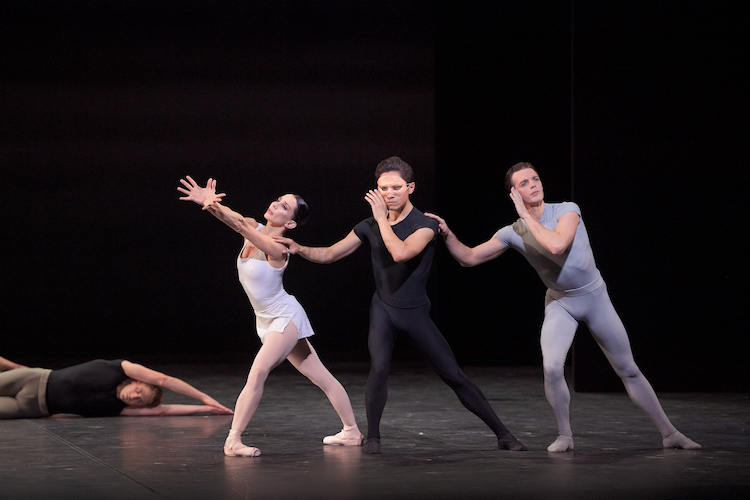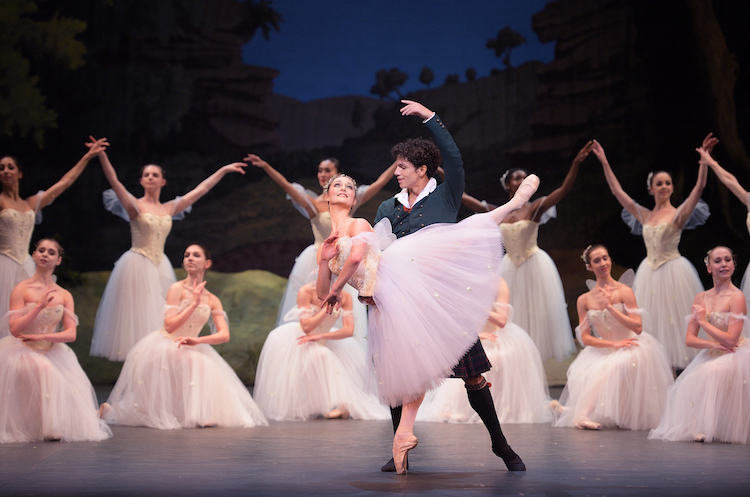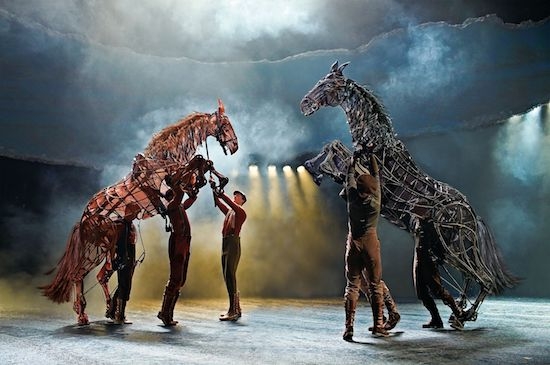English National Ballet’s stunning new double bill embodies what I love most about dance: you can lose yourself in it and it makes you think, writes Georgina Butler.
The compelling Song of the Earth / La Sylphide programme is at Milton Keynes Theatre all week and ticketholders will not be disappointed. This is another unmissable offering from a company determined to ensure ballet evolves so it has relevance for audiences, today and in the future, while simultaneously paying tribute to its glorious history.
Juxtaposing Kenneth MacMillan’s breakthrough, avant-garde masterpiece, Song of the Earth, against the quintessential Romantic era ballet, La Sylphide, is an inspired expression of English National Ballet’s enduring mission. Seeing these two new additions to the company’s repertoire performed back-to-back affords us the opportunity to admire the scope of ballet as an art form and the versatility of the dancers.
Austere staging means attention is on the melding of music and movement in Song of the Earth, an abstract work set to Austrian composer Gustav Mahler’s symphonic song cycle Das Lied von der Erde.
Tenor Simon Gfeller and mezzo soprano Flora McIntosh take it in turns standing in a downstage corner to give superb solo performances of alternate songs. There are six songs in total, created when a melancholy Mahler coupled the words from a series of ancient Chinese poems with a haunting orchestral score. Sung in their German translation to poignant passages of music - played live by English National Ballet Philharmonic under conductor Gavin Sutherland – these songs chart the fragility of life and its constant renewal.
Although there is no predetermined plot, three central characters are prominent: The Woman (in white), The Man (in grey) and The Messenger of Death (in black).
Their interactions remind us that death is a constant companion to life so we should make the most of living while we can.

Artistic director and lead principal Tamara Rojo is a force to be reckoned with as The Woman, eloquently communicating the intensity of a barrage of emotions following the loss of The Man (principal Joseph Caley) to The Messenger (lead principal Aaron Robison). Rojo’s courus (those tiny, rapid runs en pointe) are some of the speediest you will ever see when The Woman eventually seems to accept her own call from death.
Caley and Robison joined English National Ballet this summer and both have technique and presence to get excited about. Notably, Robison’s elevation in big leaps gives The Messenger an impressive air of authority.
The movement seems to be married to the music; the dancers seem inseparable from the evocative soundscape. The first song showcases youthful exuberance and charm and, when the song changes, so does the mood. Initially, the individuals before us look to be savouring sweet moments of happiness and serenity.
Later, they give the impression that they might be surrendering themselves to fate. They enter a state of inertia, their bodies apparently unavoidably propelled by forces external to them. Later still, they appear to be facing up to the ubiquitous undercurrents of sorrow. At all times, music and movement are inextricably linked.
MacMillan’s choreography still looks contemporary now, even though Song of the Earth was premiered by Stuttgart Ballet back in 1965. English National Ballet’s dancers have perfected visceral, earthbound movement before – as evidenced in the commemorative triple bill Lest We Forget and Akram Khan’s shadowy Giselle – so the flexed feet and wrists, deep bends, contracted torsos and twisted positions seen in Song of the Earth are convincingly executed.
On press night, there was a real sense of raw energy but there is no mistaking the fact that the technical ballet content is complex and intricate. There was a fumbled hand here and there in some elaborate ensemble lifts (with a ratio of one female dancer to four males, any slight timing issue is going to be apparent) and, elsewhere, a pointe shoe teetered noticeably for a fraction of a second. Nonetheless, in such an involving piece of dance, I would rather see this injection of too much energy while dancing on the edge than a lacklustre performance.
In short, with Song of the Earth, English National Ballet’s dancers demonstrate a commitment to delivering emotive, engaging ballet. It leaves audience members reflecting on what they have seen, what it could mean and how it will stay with them.

After the interval, Frank Andersen’s faithful recreation of August Bournonville’s narrative ballet La Sylphide is a captivating contrast to the bare minimalism of the first work.
The set design depicts a cosy farmhouse in Scotland on the morning of the wedding of James and his wife-to-be Effy. James is fast asleep in an armchair before being woken by The Sylph, a mysterious winged creature from his dreams. As The Sylph flits weightlessly around him, it is apparent that James is bewitched by her beauty and fascinated by her presence. Of course, his infatuation leads him to risk everything he thought he wanted. As tragic consequences ensue, we are left to wonder: is it better to take a chance on the unknown or to settle for the familiar?
The staging for this La Sylphide, a version that English National Ballet is giving its UK debut this season, is exquisite. In the first scene, a gauzy curtain creates the atmospheric, dreamy quality that productions staged during the Romantic Era achieved with gas lighting. The farmhouse has a picturesque window for The Sylph to flutter in through. (A delightful finishing touch is the addition of a miniature platform which enables her to make an enviable entrance, floating down while posing in a perfect arabesque.) The Sylph’s elusive quality is similarly enhanced with other sprinklings of clever stage sorcery, notably when she disappears up the chimney and, later, from under a blanket.
English National Ballet provides time-honoured ballet bliss with this second part of the programme. A clear story, enhanced by undemanding mime; a lovely score, which combines lyrical melodies with folk tunes; gorgeous costumes… and dreamy dancing!
Both works in this double bill are open to individual interpretation to such an extent that audience members cannot help but find themselves involved in the dancing as it unfolds.
Song of the Earth is a mesmerising exploration of universal feelings and experiences, the details of which spectators must read into in whichever way resonates with them. La Sylphide has a clear narrative, yet we still decide for ourselves about the symbolism of the Sylph. Does she really exist or is she a figment of James’ imagination, conjured up because he feels trapped by the life that awaits him?
Expect to feel moved, pensive and in awe of the dancers’ talent by the curtain call!
By Georgina Butler
English National Ballet’s ‘Song of the Earth / La Sylphide’ double bill continues at Milton Keynes Theatre until Saturday October 21.
Click here to book.
For more dance and theatre reviews, interviews, news and features from Georgina, visit https://georginabutler.co.uk and follow her on Twitter @GeorginaLButler
> Never miss leisure news in Milton Keynes - Follow us on www.twitter.com/thisistotalmk
And on Facebook: www.facebook.com/thisistotalmk















